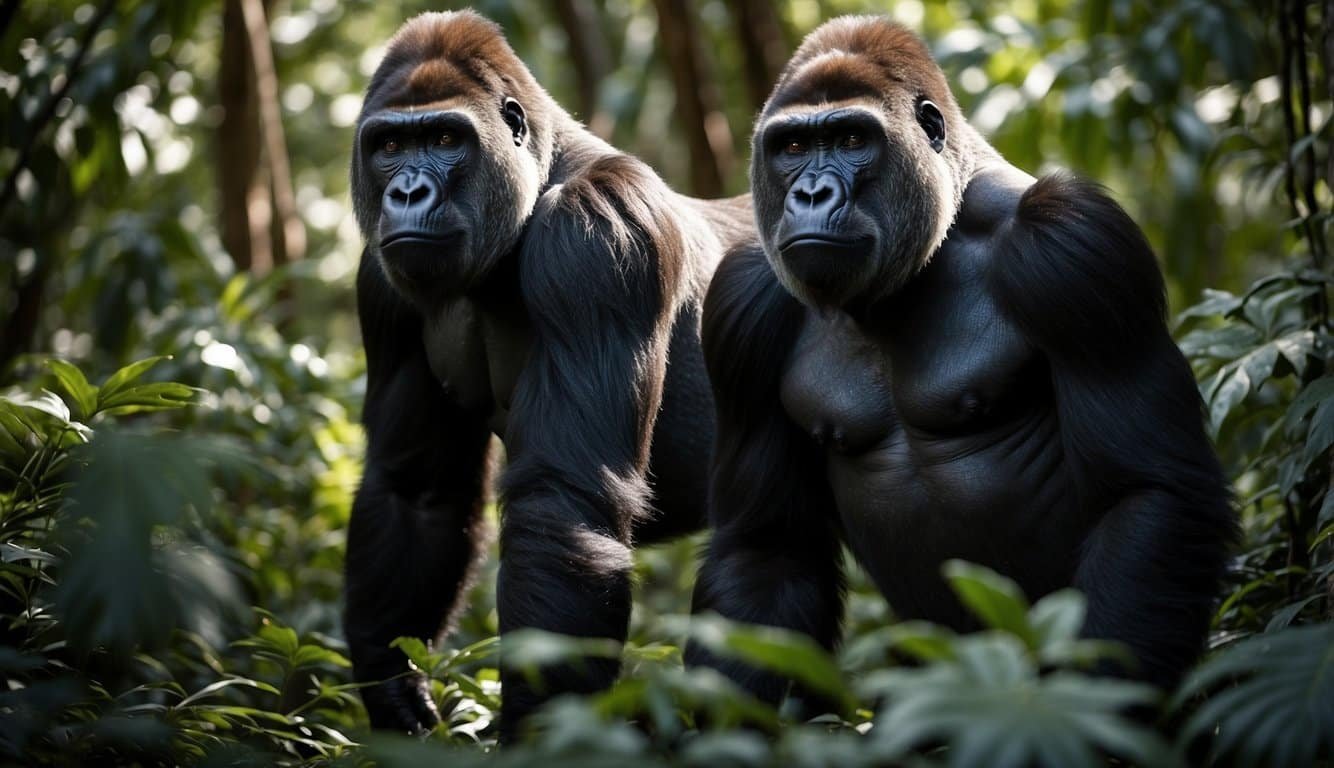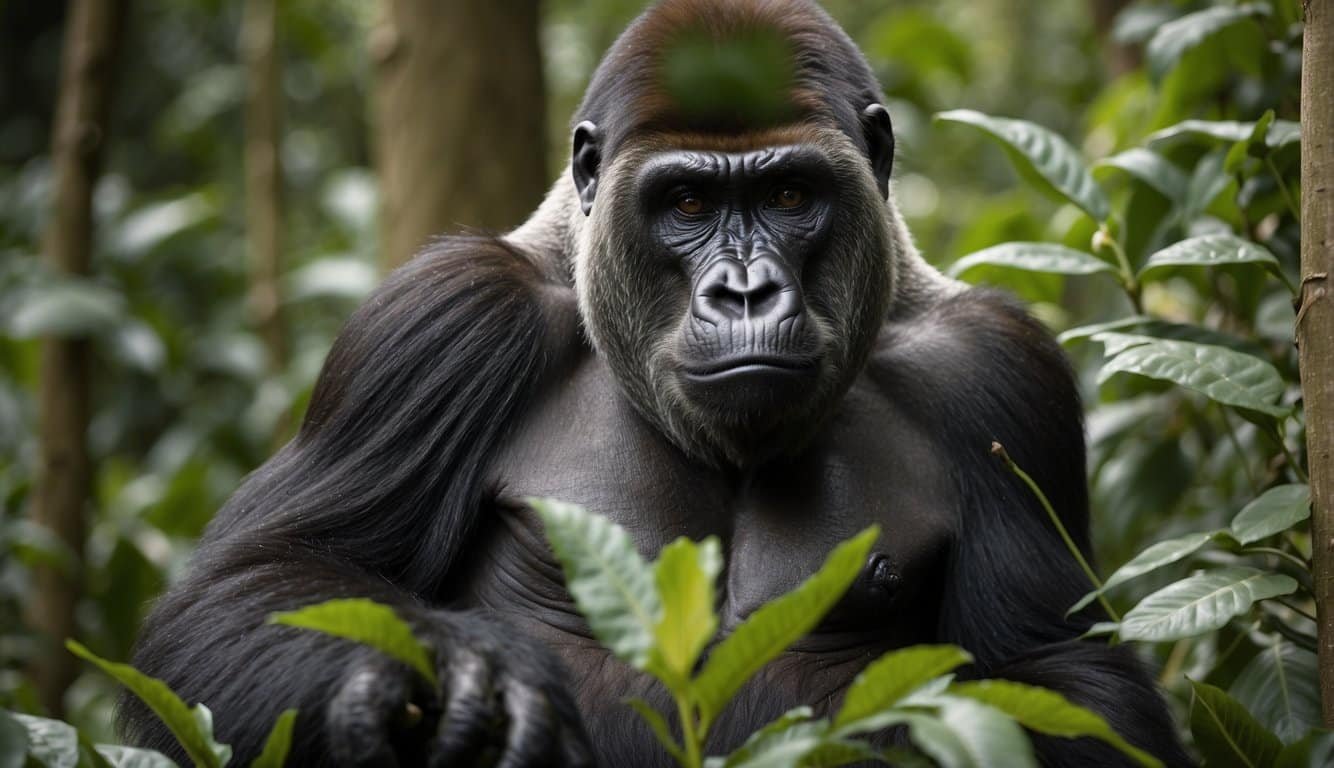Gorilla Species Overview

Gorillas, one of our closest animal relatives, are majestic primates known for their intelligence and strength. In this section, we’ll explore their diversity, behavior, social interactions, diet, and the pressing issue of their conservation.
Distinct Subspecies and Their Habitats
There are four recognized gorilla subspecies, each residing in distinct regions of Africa. The western lowland gorilla is found in several Central African countries, inhabiting dense forests and swamps. The mountain gorilla is much fewer in numbers and occupies the forested slopes of the Virunga Mountains and Bwindi Impenetrable National Park. Across the Congo River, the eastern lowland gorilla or Grauer’s gorilla roams the lowland tropical forests. Lastly, the Cross River gorilla lives in a small region between Nigeria and Cameroon.
Physical Characteristics and Behaviors
Gorillas exhibit sexual dimorphism, with males notably larger than females, some males reaching weights up to 200 kg (440 lbs), and boasting a silver saddles of hair known as a “silverback.” These apes have broad chests, dark, thick skin, and possess unique fingerprints just like humans. Their strength is remarkable, estimated at six times that of a human, which they rarely use in aggressive ways.
Social Structure and Reproduction
Gorilla groups, known as troops, are led by a dominant silverback who decides the activities of the family, protects them, and has breeding rights with the females. Family groups typically include several female gorillas, their infants, and sometimes subordinate males called blackbacks. At around 10 years of age, males reach maturity and can challenge the dominant silverback or depart to form their own group.
Dietary Habits
These great apes are primarily herbivores, consuming fruits, bamboo shoots, leaves, and stems. However, their diet can be diverse, including insects like termites. Their significant intake of vegetation helps maintain their substantial size and muscle mass.
Conservation Status
Currently, all gorilla subspecies are listed on the IUCN Red List with statuses ranging from endangered to critically endangered. The largest threat they face is habitat destruction due to logging, mining, and agriculture. Additionally, poaching and disease also significantly impact their populations. Organizations worldwide are involved in conservation efforts, including habitat preservation, anti-poaching patrols, and supporting local community initiatives.
Human Interactions and Gorillas

Gorilla encounters with humans span from intimate connections in captivity to complex interrelations impacting their survival in the wild. This section delves into the nuances of their captivity, the threats they face, ongoing conservation work, and their cultural resonance.
Gorillas in Captivity
In zoos, gorillas adapt their behaviors based on their familiarity with human caregivers. Studies have shown that these interactions can range from playful to cautious, varying with each individual captive gorilla. Researchers have even noted that gorillas modify their behavior when encountering familiar and unfamiliar humans, which can greatly influence their well-being in zoological parks.
Threats to Survival
The survival of gorillas is heavily impacted by human activities. Poaching for bushmeat, along with habitat destruction from logging and agriculture, ranks high among the multiple threats to gorilla populations. Diseases, such as the Ebola virus, also pose a significant risk, decimating gorilla numbers in their natural habitat.
Conservation and Research Efforts
Understanding gorilla behavior is crucial for effective conservation. Research into their complex communication, including the use of sign language by individuals like the famous Koko, has provided insights into their emotional capabilities. These findings drive conservation and research efforts, focusing on protecting habitats and reducing the human-induced threats that these majestic apes face.
Cultural Significance and Recognition
Historically, gorillas have held a significant place in human culture, inspiring awe and a shared sense of kinship due to their close DNA relationship with humans. Cross River gorillas and other varieties have often featured in local folklore and have been a focal point for international conservation campaigns. Recognizing their cultural significance further emphasizes the importance of gorilla conservation.

